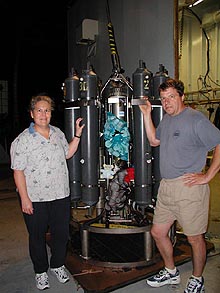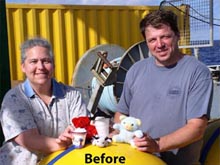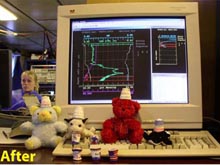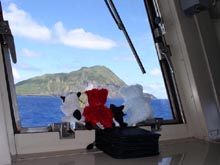
Sharon Walker and Geoff Lebon make sure that the "backpack buddies" and the mesh bags with the cups are secured to the CTD frame before putting them in the water. Click image for more information and larger view.
The Pressure is on!
February 26, 2003
Sharon Walker and Geoff Lebon
We have the unique opportunity to bring science and exploration into the classrooms where our daughters attend school. Fourth graders in Mrs. Barb McGrath’s class at Our Lady of the Lake School in Seattle, WA, and in Mrs. Andrea Anderson’s class at Shelton View Elementary School in Bothell, WA, are participating in an experiment to explore the extreme pressure of the deep ocean. Before the expedition, we visited these classes to explain our expedition to the students. Even though the summits of some of the volcanoes we are visiting on this trip are very shallow, they are surrounded by the deep ocean floor.
In fact, the Challenger Deep is located in the Mariana Trench not far from here and is the deepest spot in the ocean anywhere on Earth. Many vent sites in this area and around the world are situated in very deep locations. The amazing organisms living around deep vents must be well adapted to extreme pressures.
To help the students learn about extreme pressure in the deep ocean, each student received a Styrofoam cup to decorate. The cups were sent to the bottom of the ocean during a recent CTD cast to a depth of 2,900 meters—nearly 2 miles deep!

Before: Scientists Sharon Walker and Geoff Lebon hold Styrofoam cups decorated by students in their daughters’ fourth grade classes along with four “backpack buddies” from Geoff’s daughter’s class. Click image for more information and larger view.

After: The backpack buddies are surrounded by cups that have been to the bottom of the ocean, and they make perfect hats. They are sitting in front of the computer the scientists use during CTD casts to monitor the data for hydrothermal plumes. Click image for more information and larger view.
The cups were placed in mesh bags and attached to the CTD frame. As the cups descended, the pressure squeezed all the air out of the foam, shrinking the cups to a fraction of their original size. The pressure of the water is equal in all directions, so the cups retain their shape, and the result is a perfect miniature version of the original. The pressure at 2,900 m under water is equal to about 290 atmospheres (or 290 times greater than the pressure we experience at sea level). It is hard to imagine what that feels like, but the change in the cups' size is a dramatic and interesting demonstration of what such pressure can do.

Tiny, Furball, Patty and Hugger enjoying the striking scenery of Sarigan Island. Click image for more information and larger view.
Mrs. McGrath’s class also sent along several “backpack buddies.” These mascots, named Tiny, Furball, Patty and Hugger, are being photographed watching the activities taking place all around the ship, including scientific operations, various aspects of ship life, and the striking scenery of the volcanic islands we are sailing near. The photos are being sent back to the class with descriptions to give the class an overall view of what is going on during our cruise and some of the equipment and techniques we use. While this expedition is taking the backpack buddies to a faraway and exotic destination, other buddies from the class have been to equally interesting and remote places, such as Antarctica.

















